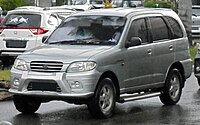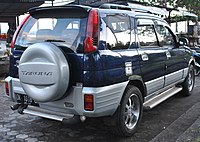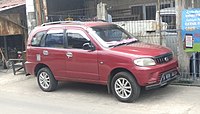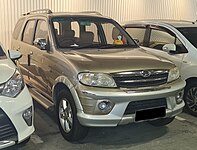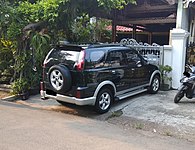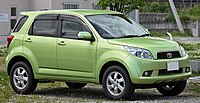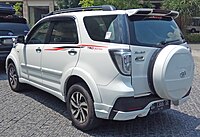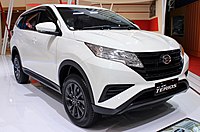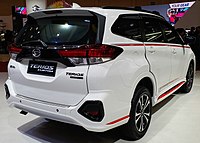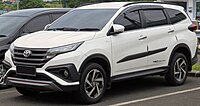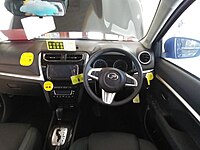Daihatsu Terios
| Daihatsu Terios | |
|---|---|
 2018 Daihatsu Terios R Deluxe (F800RG, Indonesia) | |
| Overview | |
| Manufacturer | Daihatsu |
| Also called |
|
| Production | April 1997 – present |
| Body and chassis | |
| Class |
|
| Body style | 5-door SUV |
| Layout |
|
| Chassis | Unibody |
| Chronology | |
| Predecessor | Daihatsu Rocky/Feroza/Sportrak (F300) |
The Daihatsu Terios (Japanese: ダイハツ・テリオス, Hepburn: Daihatsu Teriosu) is a mini SUV produced by the Japanese automobile manufacturer Daihatsu since 1997 as the successor to the F300 series Rocky. It was initially offered in both short- and long-wheelbase configurations before the former stopped production in 2016 to be replaced by the A200 series Rocky crossover in 2019. The long-wheelbase variant is available mainly for the Indonesian market with three-row seating options. A smaller kei car model called the Terios Kid/Lucia was also available for the first-generation model.
Rear-wheel drive is standard across all generations, while four-wheel drive option was available for the first- and second-generation models.
Since August 2016, the Terios has been sold exclusively in Indonesia. Throughout three generations, it has also been marketed by Toyota and Perodua under various nameplates as well.
The name "Terios" is originated from the Old Greek word, which is roughly translated to "making dreams come true".[1][2]
First generation (J100/F500; 1997)
[edit]| First generation | |
|---|---|
 Daihatsu Terios (pre-facelift, UK) | |
| Overview | |
| Model code |
|
| Also called |
|
| Production |
|
| Assembly | |
| Body and chassis | |
| Layout | |
| Chassis | Unibody[7] |
| Powertrain | |
| Engine | |
| Power output |
|
| Transmission | |
| Dimensions | |
| Wheelbase |
|
| Length |
|
| Width |
|
| Height |
|
| Kerb weight |
|
| Chronology | |
| Successor |
|
Initially previewed as the MS-X97, the first-generation Terios was available as a five-door wagon, and a smaller kei car model called the Terios Kid, which was only released in Japan. Model codes for the first generation were J100, J102 and J122. The Terios Kid arrived in October 1998 and continued to be built six years after the original Terios had been replaced. By the end of 2002, Daihatsu sold 33,000 units of Terios and 97,000 units of Terios Kid.[9]
In 2000, Daihatsu gave the Terios a mild facelift both in the exterior and interior of the vehicle. A new chrome grille replaced the black plastic grille. The high-grade model gained electric front windows, central locking, rear seat head restraints, alloy wheels, roof rails and a roof-mounted rear spoiler. Mechanically, the 1.3-litre SOHC four-cylinder engine fitted to the previous model had been replaced by the new 1.3-litre DOHC four-cylinder engine. Power was also increased by 3 kW (4 hp; 4 PS). A sport version of the K3-VET engine was produced in Japan.
In Australia, a limited edition sports series was introduced in 2001 with only 200 units being available. The vehicle had body colour matching bumpers, different from the two-tone bumper colour on the standard model. Rear spoiler and sunroof became standard. The interior was updated with metallic paint finish on the centre console and dashboard.
This is the first Daihatsu automobile to be assembled in Venezuela, where production began in November 2001.[3][4]
-
1999 Daihatsu Terios SX (J100; pre-facelift, Australia)
-
2002 Daihatsu Terios DX (J102G; facelift, Australia)
-
2002 Daihatsu Terios SX (J102G; facelift, Australia)
-
2002 Daihatsu Terios SX (J102G; facelift, Australia)
-
Daihatsu Terios (facelift, UK)
Versions
[edit]- Terios (first generation)
- J100G 1997-1999 "HC-EJ" SOHC 1295 cc engine 89 PS (65 kW; 88 hp) 4WD
- J102G 2000-2004 4WD
- engine "K3-VE" DOHC 1297 cc engine 92 PS (68 kW; 91 hp)
- engine "K3-VET" DOHC 1297 cc Turbo engine 140 PS (103 kW; 138 hp)
- J122G 2000-2004 2WD type ( K3-VE / K3-VET )
- Terios Kid (kei model, available in the Japanese domestic market until May 2012)
- J111G ( EF-DEM ) 1998-2005 Light pressure turbo 658 cc 4WD 60 PS (44 kW; 59 hp)
- J111G ( EF-DET ) 1998-2012 Inter cooler turbo 658 cc 4WD 64 PS (47 kW; 63 hp)
- J131G ( EF-DEM ) 1998-2005 Light pressure turbo 658 cc 2WD 60 PS (44 kW; 59 hp)
- J131G ( EF-DET ) 1998-2012 Inter cooler turbo 658 cc 2WD 64 PS (47 kW; 63 hp)
- Terios Lucia (limited edition)
- J111G / J131G for 2002-2003 only; variation of Terios Kid (without rear-mounted spare tyre)
- Taruna (Indonesia)
- F500RV / F520RV 1999-2001 "HD-C" carburettor / "HD-E" EFI SOHC 1589 cc engine 85.7 PS (63 kW; 85 hp) / 90.4 PS (66 kW; 89 hp)
- F501RV / F521RV 2001-2006 "HE-E" EFI SOHC 1498 cc engine 86.1 PS (63 kW; 85 hp)
Markets
[edit]Japan
[edit]This section has multiple issues. Please help improve it or discuss these issues on the talk page. (Learn how and when to remove these messages)
|
The first-generation Terios is also known as the Toyota Cami (Japanese: トヨタ・キャミ, Hepburn: Toyota Kyami) in Japan.
-
Daihatsu Terios (pre-facelift, Japan)
-
Toyota Cami Q Aero Version (pre-facelift, Japan)
-
Toyota Cami (pre-facelift, Japan)
-
Toyota Cami (facelift, Japan)
Terios Kid / Terios Lucia
[edit]A kei car version called the Terios Kid or Terios Lucia was also available in the local market. The 4WD version of the Terios Kid was introduced in October 1998, with a rear-wheel-drive version following in January 2000. Production of both versions ended in June 2012. The Terios Lucia was available from December 2001 until August 2003.
-
Daihatsu Terios Kid Aerodown (pre-facelift, Japan)
-
Daihatsu Terios Kid (pre-facelift, Japan)
-
Daihatsu Terios Kid (first facelift, Japan)
-
Daihatsu Terios Kid (first facelift, Japan)
-
Daihatsu Terios Kid Custom (second facelift, Japan)
-
Daihatsu Terios Kid Custom (second facelift, Japan)
-
Daihatsu Terios Lucia (Japan)
-
Daihatsu Terios Lucia (Japan)
Malaysia
[edit]In Malaysia, the Terios was locally assembled as the Perodua Kembara by Perodua. It was unveiled in August 1998. In June 2003, the Kembara was updated with DVVT engines. In July 2004, the Kembara CT Elegance was unveiled and came with ABS, front dual airbags, leather seats, different designed alloy rim, flat type side step and cubic printing cluster. It was priced at RM59,988 and only available in one colour: Klasik Gold.[10]
-
Perodua Kembara (pre-facelift, Malaysia)
-
Perodua Kembara (pre-facelift, Malaysia)
-
Perodua Kembara (facelift, Malaysia)
-
Perodua Kembara (facelift, Malaysia)
Indonesia
[edit]This section needs additional citations for verification. (January 2019) |
In Indonesia, a version of the Terios is known as the Daihatsu Taruna (chassis code: F500/F520), with a different front/rear styling and longer rear-based body capable of seating seven people. The name Taruna translates roughly as "young knight" or "cadet" in Indonesian. The Taruna was launched in July 1999 with a 1589 cc HD-C petrol engine with carburetor. It was initially available in short-wheelbase configuration only, the C-series. The engine was later replaced with a 1498 cc HE-E petrol engine with electronic fuel injection in 2001 and the long-wheelbase configuration, the F-series, was introduced with the same HD-C engine as the 1999-2001 C-series, and later replaced with the same HE-E engine as the 2001 C-series in the same year. The Taruna received facelifts in August 2001, July 2003, March 2004 and March 2005. It was available with CL and FL, CX and FX, and CSX and FGX grades. There were also CSR and FGZ special grades, which were similar to CSX and FGX, with a 1589 cc HD-E petrol engine with electronic fuel injection.[11]
A refreshed version, called Taruna Oxxy, was launched in March 2005.[12]
-
2002 Daihatsu Taruna CX (SWB, Indonesia)
-
2001 Daihatsu Taruna CSR (SWB, Indonesia)
-
2001–2003 Daihatsu Taruna FL (LWB, Indonesia)
-
2001–2003 Daihatsu Taruna FGX (LWB, Indonesia)
-
2003–2004 Daihatsu Taruna FX (LWB, Indonesia)
-
2003–2004 Daihatsu Taruna FX (LWB, Indonesia)
-
2004–2005 Daihatsu Taruna CX (SWB, Indonesia)
-
2006 Daihatsu Taruna Oxxy FGX (LWB, Indonesia)
-
2005–2006 Daihatsu Taruna Oxxy FGX (LWB, Indonesia)
China
[edit]In China, the Terios was produced under two different brand names: as the Zotye 2008/Hunter and 5008 powered with a 1.5-litre engine from Mitsubishi Motors (first series body); the Zotye was an unauthorised copy of the Terios, which caused some controversy, while FAW badged the Terios as the Huali Terios or Dario.[13][14] In 2009, Daihatsu withdrew from the China market due to bad performance and sold the tooling and rights of this car to First Auto Works (FAW), who was their official joint venture partner in China. Production for the 2008 ran from 2005 to 2010, while the 5008 was produced from 2008 to 2013.
-
Huali Dario Terios (China)
Second generation (J200/F700; 2006)
[edit]| Second generation | |
|---|---|
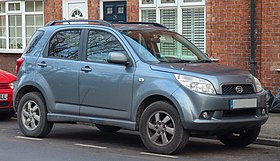 2008 Daihatsu Terios SE (J200RG; pre-facelift, UK) | |
| Overview | |
| Model code |
|
| Also called |
|
| Production |
|
| Assembly | |
| Designer | |
| Body and chassis | |
| Layout | |
| Chassis | Unibody |
| Related | Daihatsu Xenia (F600) (F700 model) |
| Powertrain | |
| Engine |
|
| Power output |
|
| Transmission |
|
| Dimensions | |
| Wheelbase |
|
| Length |
|
| Width |
|
| Height |
|
| Kerb weight |
|
| Chronology | |
| Successor |
|
The concept model called D-Compact 4x4 made an appearance in September 2005 at the 61st Frankfurt Motor Show and in November 2005 at the 39th Tokyo Motor Show before being named to Terios, which went into production in January 2006. The model codes are J200, J210 and J211 for the short-wheelbase configuration which has a 5-seater configuration; F700 and F710 for the long-wheelbase configuration that was built to accommodate the 7-seater configuration. It is built on a "built-in ladder frame" monocoque body, which is claimed to "achieve balance between lighter weight, higher body rigidity, and comfort".[23]
In European, South American and most other Asian markets, the model is sold under the name Terios. Daihatsu designed and manufacture the Terios and also supplies the vehicle to Toyota as the Toyota Rush (Japanese: トヨタ・ラッシュ, Hepburn: Toyota Rasshu) under a consigned/OEM manufacturing agreement.[24] According to the company, the name "Rush" is inspired from a "sense of energetic vitality and cheerfulness".[23]
Markets
[edit]Japan
[edit]For the Japanese market, the first-generation Terios was succeeded by the Daihatsu Be‣go (Japanese: ダイハツ・ビーゴ, Hepburn: Daihatsu Bīgo) and the first-generation Toyota Rush. Both vehicles were announced on 17 January 2006. According to Daihatsu, the name "Be‣go" was derived from the combination of "being" and "going" words. The Rush was an exclusive model to the Toyopet Store dealership network.[23]
Both use either 1.3-litre or 1.5-litre engine. Only the 1.5-litre variant is available with both two- or four-wheel drive. The vehicle has a permanent 4WD system via lockable central differential. However, it lacks low ratio gears.
A minor refresh of the Be‣go and Rush was unveiled on 13 November 2008 in Japan. The minor facelift brought redesigned front bumper, tail lamps, alloy wheel design for the G grade and a 5% improvement for fuel economy for the 2WD automatic model.[25] The Be‣go and Rush were discontinued in March 2016 and succeeded by the A200 series Rocky/Toyota Raize crossover in November 2019.[26][27][28][29]
-
Toyota Rush (J200E; pre-facelift, Japan)
-
Toyota Rush (J200E; pre-facelift, Japan)
Indonesia
[edit]The second-generation Terios and first-generation Rush were both launched in Indonesia on 14 December 2006, with the former succeeded the Taruna. Both cars were sold in long-wheelbase configuration and rear-wheel drive layout only.[1] Three-row seating were standard on the Terios and optional on the Rush. The Terios was initially offered in TS, TS Deluxe, TS Extra, TX Deluxe, TX Elegant and TX Adventure grade levels, while the Rush came with G and S grades. On 1 October 2008, the Indonesian market Terios received updates such as standard body-coloured side body mouldings, as well as side visors, single SRS airbag on the driver's side and parking sensors, followed by the Rush in August 2009. The TX Elegant grade was removed in this update.
The Terios and Rush received their first facelift on 5 and 6 October 2010 respectively, equipped with dual SRS airbags as standard. The S grade of Rush was later replaced by TRD Sportivo grade on 29 August 2013.[30] At the same time, the Terios received some minor updates.
On 20 March 2015, both the Terios and Rush received their second facelift, consisted of projector headlamps with LED positioning lamps, a wider grille with a chrome lower bar, a full-width air intake for the lower bumper and a blacked-out centre piece. The steering wheel was updated to the one used in F650 series Xenia/Avanza. The grade levels for Terios were renamed to X, X Extra, R and R Adventure.[31] On 18 February 2016, the R Custom grade was added for the Terios, followed by TRD Sportivo Ultimo grade (with TRD suspension kits) for the Rush on 26 February. Three-row seating became standard on both TRD Sportivo grades.[32]
Singapore
[edit]In Singapore, the Terios is offered by the local distributor in both short- and long-wheelbase configurations with an 1.5-litre engine and as a 4WD as standard.
Malaysia
[edit]In Malaysia, the second-generation Terios is available as the Toyota Rush (2008 to 2017) and Perodua Nautica (2008 to 2009). The Rush was introduced in January 2008 as a long-wheelbase model. Imported from Indonesia, it offers three-row seating as standard.[33] The Nautica was introduced in April 2008 as a rebadged model of the short-wheelbase Terios/Rush. Available with standard four-wheel drive, it was imported from Japan as the replacement to the Perodua Kembara.[34]
Toyota Rush
[edit]The first-generation Rush was launched in Malaysia in January 2008. It is available in two grade levels: 1.5G (with either manual or automatic transmission) and 1.5S (with automatic transmission only). The Rush sold in Malaysia is the long-wheelbase model in seven-seat configuration.[33]
In December 2010, the Rush received its first facelift for 2011.[35]
In April 2015, the Rush received its second facelift with the same model in the Indonesian market. Exterior changes included redesigned front bumper, radiator grille and bonnet. The bumper is finished in a two-tone effect and the grille is finished with faux carbon-fibre. Elsewhere, there is a new integrated chrome lining highlight running across the headlamp and radiator grille, restyled tail lamps with combination LEDs and smoked lenses. The 1.5S has additional equipment including fog lamps, chrome covers for the wing mirrors, and leather steering wheel and gear knob.[36]
Perodua Nautica
[edit]
Perodua launched the rebadged version of the short-wheelbase Terios, called Nautica in May 2008.[37] The model was fully imported from Japan, except for the front grille, front bumper and rear bumper which are manufactured and fitted in Malaysia. It has a 1.5-litre DVVT engine, full-time 4WD, projector headlamps, and five seats with dark interior. The price tag of the Nautica is not much different from the long-wheelbase Rush. It comes with only two colour choices: Medallion Grey and Majestic Black, and comes in automatic transmission only. The Nautica was quietly discontinued in 2009, slightly less than a year after its launch. Only a mere total of 489 units were ever sold.[38] The reason for the discontinuation was because as a national car company focused on local manufacturing, Perodua was unable to obtain sufficient necessary Approved Permits for vehicle importation, as the Nautica was imported in CBU form from Japan.[34]
South America
[edit]In Chile, the second-generation Terios in short-wheelbase configuration was launched in 2006. It was re-branded as the Toyota Rush in August 2016, as Daihatsu left that market.[39][40]
South Africa
[edit]The second-generation Terios was released in South Africa in 2006 as a short-wheelbase 4x4 and 4x2 model.[41][42] In 2008, the three-row long-wheelbase model was released, which was imported from Indonesia.[43] Sales ended in 2015 when Daihatsu left the market.[44]
Safety
[edit]2015 Toyota Rush ASEAN NCAP scores:
| Score | Rating | |
|---|---|---|
| Adult Occupant Protection | 12.47/16.00 | |
| Child Occupant Protection | 40.29/49.00 (82%) | |
| Safety Assist | N/A | |
Awards
[edit]In 2006, the Terios won the Red Dot Design Award.[45]
Gallery
[edit]Short-wheelbase
[edit]- Daihatsu Terios
-
2008 Daihatsu Terios SE (J200RG; pre-facelift, UK)
-
Daihatsu Terios (J200LG; first facelift, Germany)
-
Daihatsu Terios (J200LG; first facelift, Germany)
Long-wheelbase
[edit]- Daihatsu Terios
-
2007 Daihatsu Terios TX Deluxe (F700RG; pre-facelift, Indonesia)
-
2009 Daihatsu Terios Advantage (F700LG; pre-facelift, Chile)
-
2011 Daihatsu Terios TS Deluxe (F700RG; first facelift, Indonesia)
-
2013 Daihatsu Terios TX Deluxe (F700RG; first facelift, Indonesia)
-
2014 Daihatsu Terios TX Adventure (F700RG; first facelift, Indonesia)
-
2016 Daihatsu Terios R Adventure (F700RG; second facelift, Indonesia)
- Toyota Rush
-
2010 Toyota Rush S (F700RE; pre-facelift, Indonesia)
-
2013 Toyota Rush S (F700RE; first facelift, Indonesia)
-
2013 Toyota Rush G (F700RE; first facelift, Indonesia)
-
2014 Toyota Rush TRD Sportivo (F700RE; first facelift, Indonesia)
-
2015 Toyota Rush G (F700RE; second facelift, Indonesia)
-
2016 Toyota Rush TRD Sportivo Ultimo (F700RE; second facelift, Indonesia)
-
2017 Toyota Rush TRD Sportivo (F700RE; second facelift, Indonesia)
Third generation (F800/F850; 2017)
[edit]| Third generation | |
|---|---|
 2018 Daihatsu Terios R (F800RG; pre-facelift, Indonesia) | |
| Overview | |
| Model code |
|
| Also called |
|
| Production | November 2017 – present |
| Assembly |
|
| Designer | |
| Body and chassis | |
| Layout | Front-engine, rear-wheel-drive |
| Chassis | Unibody |
| Related | Daihatsu Xenia (F650) |
| Powertrain | |
| Engine |
|
| Power output | 76.5 kW (103 hp; 104 PS) |
| Transmission |
|
| Dimensions | |
| Wheelbase | 2,685 mm (105.7 in) |
| Length | 4,435–4,466 mm (174.6–175.8 in) |
| Width | 1,695 mm (66.7 in) |
| Height | 1,705 mm (67.1 in) |
| Kerb weight | 1,245–1,270 kg (2,745–2,800 lb) |
The third-generation Terios was unveiled in Indonesia on 23 November 2017, along with the second-generation Rush.[50][51][52][53] The development of the car was led by chief engineer Eiji Fujibayashi in 2015, with its design influenced from the FT Concept.[54][55][56] Unlike previous models, these generation of cars are sold in long-wheelbase configuration only and neither the short-wheelbase configuration nor four-wheel drive option are offered. It uses the same platform as the long-wheelbase version of the second-generation model, albeit with some tweaks.
Compared to its predecessors, the design of the car has been made more streamlined, akin to crossovers. This model has a rear liftgate rather than a side-opening rear door and no longer has the spare tyre mounted on the rear door.
The model codes are F800 for the Terios/international market Rush and F850 for the Malaysian market Rush/Perodua Aruz.
Markets
[edit]Indonesia
[edit]The Indonesian market Terios/Rush went on sale on 3 January 2018.[57][58] Both models are offered only in three-row configuration. With the third row backrest folded down, there are 217 L (7.7 cu ft) of storage space, which is expanded to 514 L (18.2 cu ft) when tumbled up.[59]
The Terios was initially available in 4 grade levels: X, X Deluxe, R and R Deluxe. The R Custom grade was later added in August 2018.[60] The Rush came with G and TRD Sportivo grades.
Due to high demand, the production of Terios and Rush was also conducted in Astra Daihatsu Motor's Karawang plant alongside the Sunter plant since August 2019.[61][62]
In August 2021, the TRD Sportivo grade of Rush was renamed to GR Sport. Redesigned bumper add-ons and side body mouldings were included in this update.[63] It also received start-stop system as standard, followed by Terios in September.[64]
The facelifted Terios was launched on 8 June 2023 with X, R and R Custom grades, while the X Deluxe and R Deluxe grades were discontinued.[65] Optional Astra Daihatsu Styling (ADS) package with exterior add-ons and other accessories is available for X and R grades.[66]
The GR Sport grade of the Rush was updated on 1 April 2024, changes includes a new grille, black exterior parts, new alloy rim designs, and a new 9" touchscreen infotainment system. The G grade remained unchanged.[67]
Philippines
[edit]The Rush was released in the Philippines on 4 May 2018 and was initially offered in two grade levels: E, which has five seats and is available with either manual or automatic transmission, and G, which has seven seats and is only available with an automatic transmission.[68][69][70]
In November 2020, the E grade received a reverse camera and 7-seater as standard.[71]
In May 2022, the GR Sport grade was launched which replaced the previous top-spec G grade. The Rush was also updated with an updated 7-inch infotainment system with Apple CarPlay and Android Auto compatibility as standard for both the E and GR Sport grades.[72]
In January 2024, the E grade was removed from the lineup, leaving only the GR Sport as the sole grade.[73]
Brunei
[edit]After the replacement of the first- and second-generation Terios (sold under Daihatsu badge), the Rush was released in Brunei on 5 May 2018.[74] The car is available in mid- or high-grade model lineups, four-speed automatic transmission and seven-seat variant only.
Bangladesh
[edit]In Bangladesh, the Rush is available in two grade level: G and S, which has 7 seats and 4-speed automatic transmission option only. S has minor cosmetic changes and a button on steering wheel for accepting call [75]
United Arab Emirates
[edit]The Rush was released in UAE on 14 May 2018.[76][77] Only a seven-seater version is available.
South Africa
[edit]The Rush was released in South Africa on 4 July 2018, replaced the previous Daihatsu-badged Terios.[78] It is only available in a five-seat version and offered in five-speed manual or four-speed automatic options.
Jamaica
[edit]The Rush was released in Jamaica on 8 July 2018.[79] Only a seven-seater version is available.
New Caledonia (France)
[edit]The Rush is currently on sale, as of May 2024, in this sui generis French Overseas Collectivity.[80] It is the only place in the entire French Republic where the Rush can be purchased officially.
Colombia
[edit]The Rush was released in Colombia on 26 July 2018.[81][82][83] Only a seven-seater version is available.
Pakistan
[edit]The Rush was unveiled in Pakistan on 31 August 2018. It went on sale on 10 September 2018. Three variants are available and there is only a seven-seat option.[84][85][86]
Malaysia
[edit]Toyota Rush
[edit]The Rush was launched in Malaysia on 18 October 2018. It was assembled by Perodua as a complete knock-down unit at its plant in Rawang, Selangor. There is only a seven-seat variant. It is only available with a four-speed automatic transmission though two grade levels were offered: 1.5 G and 1.5 S. The 1.5 S grade is equipped with a pre-collision system.[59] It was discontinued due to low sales in January 2024.[87]
Perodua Aruz
[edit]The Rush is also sold by Perodua as the Perodua Aruz, which was launched on 15 January 2019.[46] The name "Aruz" is taken from the Malay word "arus", meaning "flow".[88] A media preview occurred in December 2018 while booking opened on 3 January 2019, and since then has made 2,200 bookings at the time of launch.[89][90] There is only a seven-seat version. It is available only with a four-speed automatic transmission though two grade levels are available: 1.5 X and 1.5 AV (Advance). By March 2019, Perodua had successfully delivered 4,000 units of the Aruz with a total booking count at 14,000,[91] and by the beginning of June 2019, roughly 13,000 Aruz had been delivered with a total booking count standing at 25,000.[92]
The Aruz was went on sale in Singapore on 13 April 2021 and the car were offered only in 1.5 X variant.[93]
Safety
[edit]Toyota Rush
[edit]| Overall stars | |
| Adult occupant | 31.14/36.00 |
| Child occupant | 41.81/49.00 |
| Safety assist | 15.00/18.00 |
Perodua Aruz
[edit]| Overall stars | |
| Adult occupant | 31.14/36.00 |
| Child occupant | 41.19/49.00 |
| Safety assist | 16.00/18.00 |
Recalls
[edit]On 15 July 2019, Toyota had announced that around 60,000 units of the Indonesian market Rush manufactured from December 2017 to February 2019 would be recalled due to a problem regarding the airbags. It is stated that the affected models were found to have an improperly programmed airbag control module which could cause the side curtain airbags to accidentally deploy even when the vehicle is running normally. An impact on the rear wheel when passing a pothole or dent may be misinterpreted as a collision, which may cause deployment of the side curtain airbags. The Terios models were not affected due to the fact that the model is not being equipped with side curtain airbags.[96][97][98][99][100][101]
Awards
[edit]In July 2018, the car won the "Good Design Indonesia of The Year" award.[102][103][104]
Gallery
[edit]- Daihatsu Terios
-
2018 Daihatsu Terios X Deluxe (F800RG; pre-facelift, Indonesia)
-
2018 Daihatsu Terios X Deluxe (F800RG; pre-facelift, Indonesia)
-
2019 Daihatsu Terios R Custom (F800RG; pre-facelift, Indonesia)
-
2018 Daihatsu Terios R Custom (F800RG; pre-facelift, Indonesia)
-
2024 Daihatsu Terios X (F800RG; facelift, Indonesia)
-
2023 Daihatsu Terios X ADS (F800RG; facelift, Indonesia)
-
2023 Daihatsu Terios X ADS (F800RG; facelift, Indonesia)
-
2021 Daihatsu Terios R Deluxe interior (Indonesia)
-
Daihatsu FT Concept
- Toyota Rush
-
2018 Toyota Rush S (F800LE, Laos)
-
2018 Toyota Rush S (F800LE, Laos)
-
2018 Toyota Rush TRD Sportivo (F800RE, Indonesia)
-
2018 Toyota Rush TRD Sportivo (F800RE, Indonesia)
-
2021 Toyota Rush GR Sport (F800RE, Indonesia)
-
2024 Toyota Rush GR Sport (F800RE, Indonesia)
-
2018 Toyota Rush TRD Sportivo interior (Indonesia)
- Perodua Aruz
-
2019 Perodua Aruz AV (F850RG, Malaysia)
-
2019 Perodua Aruz AV (F850RG, Malaysia)
-
Interior
Sales
[edit]| Year | Indonesia | Malaysia[105][i] | Philippines | Vietnam | ||||
|---|---|---|---|---|---|---|---|---|
| Daihatsu Terios | Toyota Rush | Perodua Kembara | Perodua Nautica | Toyota Rush | Perodua Aruz | Toyota Rush | Toyota Rush | |
| 2000 | 12,325 | |||||||
| 2001 | 13,859 | |||||||
| 2002 | 10,882 | |||||||
| 2003 | 9,550 | |||||||
| 2004 | 6,124 | |||||||
| 2005 | 4,298 | |||||||
| 2006 | 2,261 | |||||||
| 2007 | 783 | |||||||
| 2008 | 28 | 475 | 5,985 | |||||
| 2009 | 3 | 19 | 3,024 | |||||
| 2010 | 0 | 0 | 2,473 | |||||
| 2011 | 2,488 | |||||||
| 2012 | 1,800 | |||||||
| 2013 | 1,148 | |||||||
| 2014 | 18,774[106] | 29,609[107] | 669 | |||||
| 2015 | 13,375[108] | 26,848[107] | 250 | |||||
| 2016 | 14,238[109] | 24,371[110] | 76 | |||||
| 2017 | 11,338[111] | 20,039[112] | 32 | |||||
| 2018 | 31,453[113] | 53,145[113] | 0 | 10,760[114] | ||||
| 2019 | 22,960[115] | 61,569[115] | 2,792 | 30,114 | 15,172[116] | 2,305 | ||
| 2020 | 12,362[117] | 29,361[117] | 2,449 | 22,494 | 10,194[118] | 4,241 | ||
| 2021 | 18,996[119] | 52,553[120] | 2,373 | 15,314 | 12,564[121] | 1,781 | ||
| 2022 | 24,825[122] | 44,991[122] | 2,586 | 19,624 | 14,871[123] | |||
| 2023 | 24,226[124] | 39,340[124] | 1,069 | 21,324 | 9,437[125] | |||
- ^ Figures based on registration (Malaysia)
References
[edit]- ^ a b "PT Astra Daihatsu Motor Luncurkan Daihatsu Terios" [PT Astra Daihatsu Motor launches the Daihatsu Terios]. Daihatsu Press Release (in Indonesian). PT. Astra Daihatsu Motor. 14 December 2006. Archived from the original on 10 January 2007.
- ^ "Wah, Ternyata Ini Arti Nama Daihatsu Terios - GridOto.com". jip.gridoto.com.
- ^ a b "Annual Report 2002" (PDF). Osaka, Japan: Daihatsu Motor Co. March 2002. p. 14. Archived from the original (PDF) on 18 December 2010.
- ^ a b "Daihatsu and Toyota Producing the Terios". DAIHATSU Global Website.
- ^ "Toyota and Daihatsu to Increase Production Capacity in Indonesia" (Press release). Daihatsu. 26 April 2005. Archived from the original on 24 June 2016. Retrieved 22 August 2019.
- ^ "DARIO CA7130S TERIOS". www.zqzd.com.
- ^ Stopford, William (5 November 2023). "Curbside Capsule: 1997-2005 Daihatsu Terios – Twenty Years Early". Curbside Classic. Retrieved 21 April 2024.
- ^ Uchida, Shunichi (18 August 2020). "ダイハツ「タフト」チーフエンジニア小村氏が明かす「経済性・扱い易さ・安心感・安全性」と「非日常感」の融合秘話" [Daihatsu "Taft" chief engineer Mr. Komura reveals the secret story of "economy, ease of handling, security and safety" and "unusual feeling"]. Impress.co.jp (in Japanese). Japan: Impress Corporation. Retrieved 29 August 2020.
- ^ "Terios to Be Produced in China Under New Technical Licence Agreement with FAW Huali (24 Jan 2003)" (Press release). Daihatsu. 24 January 2003. Retrieved 13 January 2018.
- ^ "Perodua :: News & Events :: 2004". 16 April 2007. Archived from the original on 16 April 2007. Retrieved 3 September 2017.
{{cite web}}: CS1 maint: bot: original URL status unknown (link) - ^ "Daihatsu Taruna, Kenalan sama Perintis SUV 7-Seater di Indonesia - Semua Halaman - GridOto.com". jip.gridoto.com.
- ^ "Peluncuran Taruna OXXY" [Launch of the Taruna OXXY]. Daihatsu Press Release (in Indonesian). PT. Astra Daihatsu Motor. 24 March 2005. Archived from the original on 26 August 2007.
- ^ "FAW.com". FAW. Archived from the original on 14 January 2016.
- ^ "活力小子:紧凑型SUV TERIOS 来了(多图)". Wood (in Chinese). Sohu.com. 4 October 2003. Archived from the original on 17 April 2004.
- ^ "Facilities|Company|DAIHATSU". DAIHATSU Global Website.
- ^ "A00200600961". DGIP.go.id. Pangkalan Data Kekayaan Intelektual. 12 May 2006. Retrieved 11 June 2022.
- ^ "A00200600962". DGIP.go.id. Pangkalan Data Kekayaan Intelektual. 12 May 2006. Retrieved 11 June 2022.
- ^ "A00200600963". DGIP.go.id. Pangkalan Data Kekayaan Intelektual. 12 May 2006. Retrieved 11 June 2022.
- ^ "Mark Widjaja, Mobil dengan Simple Design Tak Pernah Usang" [Mark Widjaja: A Car with Simple Design Never Gets Old]. Otomotif (in Indonesian). Indonesia. 13 September 2011. Retrieved 15 July 2019.
- ^ Kuswaraharja, Dadan. "'Desain Mobil Sampai Berdarah-darah'". detikoto.
- ^ "Sttt.. Desainer Ayla Pernah Tak Naik Kelas : Okezone Otomotif". otomotif.okezone.com/. 6 November 2012.
- ^ Media, Kompas Cyber (9 April 2018). "Mengenal Sosok Desainer Lokal di Balik Yaris TRD Sportivo". KOMPAS.com.
- ^ a b c "Daihatsu and Toyota Launch New Compact SUV". DAIHATSU Global Website. Retrieved 11 July 2021.
- ^ "Daihatsu 2010 Annual Report" (PDF). Archived from the original (PDF) on 3 March 2016. Retrieved 20 October 2011.
- ^ "2009 Toyota Rush Facelift unveiled in Japan". Paul Tan's Automotive News. 15 November 2008. Retrieved 28 July 2017.
- ^ "新車レポート:ダイハツ/トヨタ「ロッキー/ライズ」". 日経クロステック(xTECH).
- ^ "【ダイハツ ロッキー 新型】開発責任者「ダイハツならではの新ジャンルのコンパクトSUV」". レスポンス(Response.jp). 5 November 2019.
- ^ "Tokyo 2019: Daihatsu previews new compact SUV - is this an early look at Perodua's D55L B-segment SUV? - paultan.org". 23 October 2019.
- ^ "Daihatsu Rocky Bangkit Lagi, Ini Wujudnya". liputan6.com. 23 October 2019.
- ^ Pambudhy, Agung (29 August 2013). "Rush Model Baru Hadir dengan Varian TRD Sportivo" [The New Rush Appears with TRD Sportivo Variant]. Detik Oto (in Indonesian). Indonesia: Transmedia. Retrieved 8 October 2022.
- ^ "Toyota Rush, Daihatsu Terios facelift now in Indonesia". Paul Tan's Automotive News. 21 March 2015. Retrieved 28 July 2017.
- ^ "Updated 2016 Toyota Rush 7 launched in Indonesia". Paul Tan's Automotive News. 29 February 2016. Retrieved 28 July 2017.
- ^ a b "New 7-seater Toyota Rush SUV launched!". Paul Tan's Automotive News. 29 January 2008. Retrieved 28 July 2017.
- ^ a b "Perodua Nautica: official name for new Perodua SUV". Paul Tan's Automatic News. 24 April 2008. Retrieved 19 March 2019.
- ^ "Toyota Rush updated for 2011 with darker interior". Paul Tan's Automotive News. 10 December 2010. Retrieved 30 July 2017.
- ^ "2015 Toyota Rush facelift introduced in Malaysia". Paul Tan's Automotive News. 24 April 2015. Retrieved 28 July 2017.
- ^ "Perodua Nautica 4WD: Specifications and Photos - paultan.org". 9 May 2008.
- ^ "Malaysian Automotive Association Total Industry Volume".
{{cite journal}}: Cite journal requires|journal=(help) - ^ Nuñez, Beatriz (8 August 2016). "Daihatsu Terios Bego pasa a ser Toyota Rush". PuroMotor (in Spanish). Retrieved 3 September 2019.
- ^ Beher, Jorge (8 September 2016). "Toyota lanza el Rush y liquida a Daihatsu en Chile". autocosmos.com (in Spanish). Retrieved 3 September 2019.
- ^ "Daihatsu Terios 4x2 (2006) Driving Impression". Cars.co.za. 19 October 2006. Retrieved 2 May 2023.
- ^ Oxley, John. "FIRST DRIVE: Daihatsu Terios 4x4". Life. Retrieved 2 May 2023.
- ^ "Daihatsu Terios stretches to seven seats". IOL. 26 May 2008. Retrieved 2 May 2023.
- ^ "Daihatsu has pulled out of the country – what happens now? - Motoring News and Advice". www.autotrader.co.za. Retrieved 2 May 2023.
- ^ "Daihatsu Terios Receives Red Dot Design Award for 2006".
- ^ a b Lye, Gerard (15 January 2019). "2019 Perodua Aruz SUV launched in Malaysia – seven seats; ASA 2.0; two variants; RM72,900 and RM77,900". Paul Tan's Automotive News. Retrieved 15 January 2019.
- ^ "Mobil". Pangkalan Data Kekayaan Intelektual. Archived from the original on 13 August 2021. Retrieved 13 August 2021.
- ^ "AID201803371". DGIP.go.id. Pangkalan Data Kekayaan Intelektual. 3 December 2018. Retrieved 11 June 2022.
- ^ "A00201801214". DGIP.go.id. Pangkalan Data Kekayaan Intelektual. 9 July 2018. Retrieved 11 June 2022.
- ^ "All New Terios Meluncur, Begini Perubahannya". Kompas.com. 23 November 2017. Retrieved 23 November 2017.
- ^ "Ini Dia Generasi Terbaru Toyota Rush". Kompas.com. 23 November 2017. Retrieved 23 November 2017.
- ^ "New 2018 Toyota Rush SUV makes debut in Indonesia". Paul Tan's Automotive News. 23 November 2017. Retrieved 23 November 2017.
- ^ "New 2018 Daihatsu Terios makes debut in Indonesia". Paul Tan's Automotive News. 23 November 2017. Retrieved 23 November 2017.
- ^ "Sayang sekali, R&D All New Rush-Terios dilakukan di Jepang!". merdeka.com. 25 November 2017.
- ^ "Toyota All New Rush Hasil Pengembangan dari FT-Concept". Carmudi Indonesia. 24 November 2017.
- ^ Panait, Mircea (23 November 2017). "2018 Daihatsu Terios Revealed Along With All-New Toyota Rush". autoevolution.
- ^ "2018 Toyota Rush Indonesia pricing revealed – no increase despite higher specs, from RM72k-RM78k". Paul Tan's Automotive News. 3 January 2018. Retrieved 4 February 2018.
- ^ "2018 Daihatsu Terios pricing announced in Indonesia – RM58k to RM74k, most variants cheaper than before". Paul Tan's Automotive News. 4 January 2018. Retrieved 4 February 2018.
- ^ a b "2018 Toyota Rush launched in Malaysia - new 1.5L engine, Pre-Collision System, est from RM93k - paultan.org". 18 October 2018.
- ^ Dirgantoro, Danu P. "GIIAS 2018: Daihatsu Terios Dapat Varian Baru, Bodi Lebih Sporty". Oto Driver.
- ^ Purnama, Rayhand. "Hindari Inden Lama, Produksi Terios dan Rush Dipisah". teknologi (in Indonesian). Retrieved 3 February 2020.
- ^ fea. "Inden Terios Sampai 3 Bulan, Pabrikan Tambah Jalur Produksi". teknologi (in Indonesian). Retrieved 3 February 2020.
- ^ Stanly Ravel, ed. (9 August 2021). "Resmi, Toyota Luncurkan Veloz GR Sport dan 4 Model Lainnya". Kompas.com (in Indonesian). PT. Kompas Cyber Media. Retrieved 9 August 2021.
- ^ "Muluncur 17 September, Daihatsu Terios Punya Fitur Idling Stop". KOMPAS.com (in Indonesian). 16 September 2021. Archived from the original on 16 September 2021. Retrieved 30 September 2021.
- ^ fea. "Spesifikasi dan Harga Lengkap Daihatsu Terios Facelift 2023". otomotif (in Indonesian). Retrieved 15 June 2023.
- ^ Nuar, Gemilang Isromi. "GALERI: Daihatsu New Terios Hadir dengan Tiga Penyegaran Utama". Oto Driver.
- ^ Widiutomo, Aditya (2 April 2024). "Toyota Rush Improvement 2024 Meluncur, Simak Perubahan Lengkapnya". Oto Driver (in Indonesian). Retrieved 5 April 2024.
- ^ "Toyota PH launches all-new Rush SUV". motioncars.inquirer.net.
- ^ "2018 Toyota Rush launched in the Philippines - Indian Autos blog". 7 May 2018.
- ^ Peregrino, Randy S. (10 May 2018). "Toyota rolls out much-awaited Rush | Randy S. Peregrino". BusinessMirror.
- ^ "2021 Toyota Rush Now Comes with 7 Seats as Standard". CarGuide.PH. 25 November 2020. Retrieved 25 January 2021.
- ^ "You can now buy a Toyota Rush GR-S in PH for P1.176-M". Top Gear Philippines. 17 May 2022.
- ^ "Toyota Motor PH Introduces Veloz 1.5 E CVT, Discontinues Rush 1.5 E (w/ Specs)". CarGuide.PH. 15 January 2024.
- ^ "All-new Toyota Rush makes Brunei debut – Borneo Bulletin Online". 5 May 2018. Archived from the original on 19 May 2018. Retrieved 19 May 2018.
- ^ "13 cup holders, 2 men and a Toyota Rush". 15 May 2019.
- ^ "Toyota Rush launched at Dubai's Palazzo Versace – in pictures". The National. 14 May 2018.
- ^ "Al-Futtaim Toyota launches new compact SUV". www.tradearabia.com.
- ^ "Toyota debuts stylish Rush SUV: Here's how much the 'baby Fortuner' costs in SA". Wheels.
- ^ "Toyota Jamaica expecting drivers to Rush to new vehicle". jamaica-gleaner.com. 8 July 2018.
- ^ https://toyota.nc/ [bare URL]
- ^ "Toyota lanza en Cartagena una nueva propuesta: Rush". www.eluniversal.com.co. 27 July 2018.
- ^ "Sin prisa e ideal para terrenos agrestes". www.elcolombiano.com. 1 September 2018.
- ^ "Toyota Rush heads into Colombia & Pakistan". 14 August 2018.
- ^ "IMC unveils new Toyota Rush". www.thenews.com.pk.
- ^ "Toyota Rush 2018 officially launched with 3 variants". 10 September 2018.
- ^ Anjum, Darakhshan (11 September 2018). "Toyota Rush launched in Pakistan with three variants".
- ^ Chan, Mick (4 January 2024). "Toyota Rush seven-seat SUV discontinued in Malaysia". paultan.org. Malaysia. Retrieved 5 January 2024.
- ^ "Perodua Aruz SUV – explanation behind the new name - paultan.org". 3 January 2019.
- ^ "Perodua Aruz SUV – full spec-by-spec comparison". Paul Tan's Automotive News. 3 January 2019. Retrieved 3 January 2019.
- ^ "Perodua Aruz SUV - 2,200 bookings made since Jan 3 - paultan.org". 15 January 2019.
- ^ "Perodua Aruz - 14,000 bookings, 4,000 units delivered". Paul Tan's Automotive News. 18 March 2019. Retrieved 8 May 2019.
- ^ "Perodua Has Fulfilled 52% Of Its Aruz Deliveries - Auto News - Carlist.my". Carlist.my - Malaysia's No.1 Car Site. Retrieved 3 June 2019.
- ^ "Perodua Aruz launched in Singapore – RM 286,461".
- ^ "TOYOTA RUSH (2018)". Aseancap. 7 May 2018. Retrieved 30 June 2020.
- ^ "PERODUA ARUZ". Aseancap. 15 January 2019. Retrieved 30 June 2020.
- ^ "Toyota PH to issue recall for Rush SUV - Auto News". AutoIndustriya.com. 15 July 2019.
- ^ "Toyota PH recalls Rush: potholes, rough roads can trigger airbags - Auto News". AutoIndustriya.com. 15 July 2019.
- ^ Media, Kompas Cyber (15 July 2019). "Airbag Bermasalah, Toyota Recall 60.000 Rush di Indonesia". KOMPAS.com.
- ^ Kuswaraharja, Dadan. "Airbag Berpotensi Masalah, Toyota Recall 60.000 Unit Rush". detikoto.
- ^ Media, Kompas Cyber (15 July 2019). "Rush Kena Recall, Apa Kabar Terios?". KOMPAS.com.
- ^ Rayanti, Dina. "Toyota Rush Ditarik, Daihatsu Terios Aman". detikoto.
- ^ "Daihatsu Terios Raih Gelar Good Design Indonesia of The Year 2018". beritasatu.com.
- ^ "LSUV Terios Raih Good Design Indonesia of The Year | Otomotif". Bisnis.com. 21 July 2018.
- ^ "Daihatsu Terios Raih Good Design Indonesia 2018 dari Kementrian Perdagangan". Car Review Indonesia.
- ^ "Best selling cars model and brands in 2023". data.gov.my.
- ^ Octama, Carla Isati (9 March 2015). "Daihatsu Terios Terbaru Akan Hadir Bulan Ini". Beritasatu.com (in Indonesian). Indonesia: BeritaSatu. Retrieved 18 January 2022.
- ^ a b Media, Kompas Cyber (21 January 2016). "Mobil Terlaris Sepanjang 2015 - Kompas.com". Retrieved 7 December 2018.
- ^ Handayani, Indah (8 January 2016). "Daihatsu Peringkat Dua Pasar Otomotif Nasional 2015". Beritasatu.com (in Indonesian). Indonesia: BeritaSatu. Retrieved 18 January 2022.
- ^ Rafael, Eldo Christoffel (23 January 2017). Rizki Caturini (ed.). "Penjualan wholesales Daihatsu naik 13% di 2016". Kontan.co.id (in Indonesian). Indonesia: Kontan. Retrieved 18 January 2022.
- ^ Kuswaraharja, Dadan. "20 Mobil Terlaris di Indonesia Tahun 2016". Retrieved 7 December 2018.
- ^ Khoirudin, Ahmad (19 January 2018). "Bentuk Berubah, Penjualan SUV Terios Langsung Berlipat". Otosia.com (in Indonesian). Indonesia: Otosia. Retrieved 18 January 2022.
- ^ Kuswaraharja, Dadan. "20 Mobil Terlaris Tahun 2017". Retrieved 7 December 2018.
- ^ a b Jan 2019, Sales Report·17 (17 January 2019). "Sales Report Mobil Indonesia Jan-Des 2018".
{{cite web}}: CS1 maint: numeric names: authors list (link) - ^ "Philippines' 10 Best Selling Cars, Trucks and SUVs of 2018". AutoIndustriya.com. Retrieved 30 November 2020.
- ^ a b Rahadiansyah, Rangga (23 January 2020). "20 Mobil Terlaris 2019" [20 of Indonesia's Best Selling Cars in 2019]. Detik.com (in Indonesian). Indonesia: Trans Media. Retrieved 24 January 2020.
- ^ Sarne, V. Vernon B. "Toyota PH reveals 2019 per-model sales breakdown". visor.ph. Retrieved 8 February 2020.
- ^ a b Rahadiansyah, Rangga. "Bukan Avanza Rajanya, Ini Mobil Terlaris 2020 di Indonesia". detikoto (in Indonesian). Retrieved 16 January 2021.
- ^ "These are the Philippines' 10 best-selling cars of 2020". AutoIndustriya.com. Retrieved 22 January 2021.
- ^ Ihsan, M. Adika Faris (15 January 2022). Aditya Maulana (ed.). "Penjualan SUV Murah Sepanjang 2021, Rush Terlaris" [Low SUV Sales of 2021, Rush is The Best-Seller]. Kompas.com (in Indonesian). Indonesia: Kompas Gramedia. Retrieved 16 January 2022.
- ^ Andrianto, Robertus (14 January 2022). "Ini Mobil Terlaris 2021! Kamu Beli Juga?" [These Are The Best Selling Cars of 2021! You Bought One?]. cnbcindonesia.com (in Indonesian). Indonesia: CNBC Indonesia. Retrieved 14 January 2022.
- ^ "Here is Toyota PH's per-model sales breakdown in 2021". Visor. 20 January 2022. Retrieved 20 January 2022.
- ^ a b Rahadiansyah, Rangga (17 January 2023). "Honda Brio Salip Avanza di Lap Terakhir, Ini 20 Mobil Terlaris 2022" [Honda Brio Overtakes Avanza on the Last Lap, These Are 20 Best Selling Cars of 2022]. Detik Oto (in Indonesian). Indonesia: Transmedia. Retrieved 18 January 2023.
- ^ "Surprise (not)! 8 of top 10 vehicles sold in 2022 were Toyotas -- CAMPI | AutoFun". AutoFun Automotive News. 22 January 2023. Retrieved 27 January 2023.
- ^ a b Rayanti, Dina (16 January 2024). "Avanza-Brio Minggir Dulu, Ini Dia Mobil Terlaris di Indonesia Tahun 2023" [Move aside Avanza-Brio, here is the best selling car in Indonesia in 2023]. Detik Oto (in Indonesian). Indonesia: Transmedia. Retrieved 16 January 2024.
- ^ "Which Models Drove Toyota PH Sales Past 200K In 2023?". CarGuide.PH. 24 January 2024.
External links
[edit]- Official website (Terios, Indonesia)
- Official website (Rush, Indonesia)






















